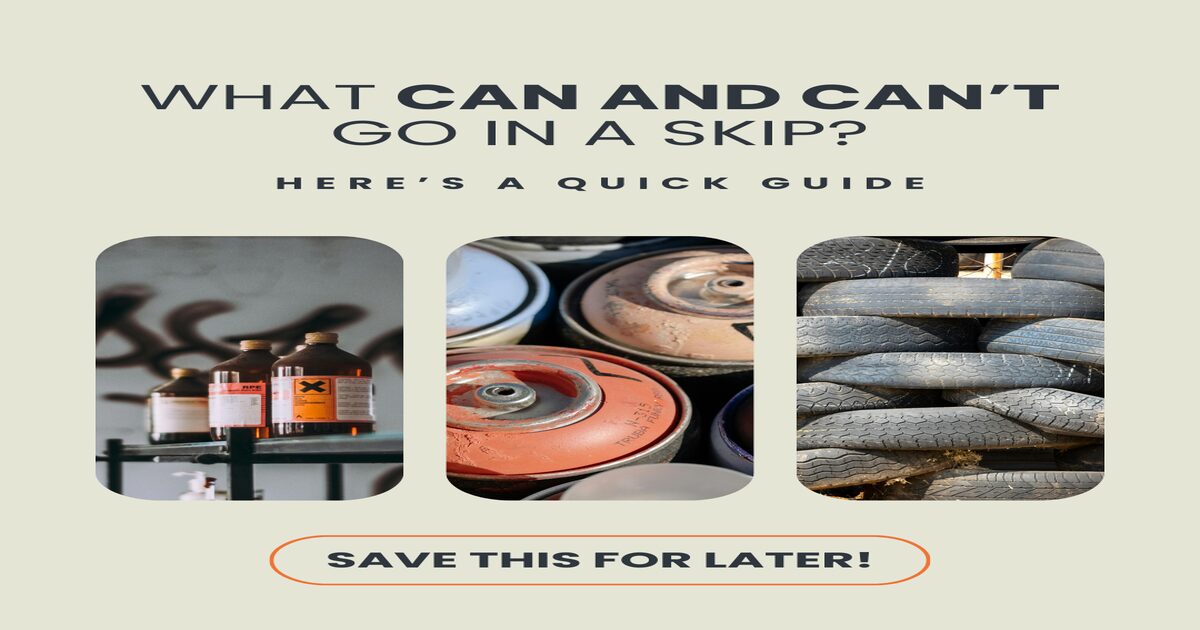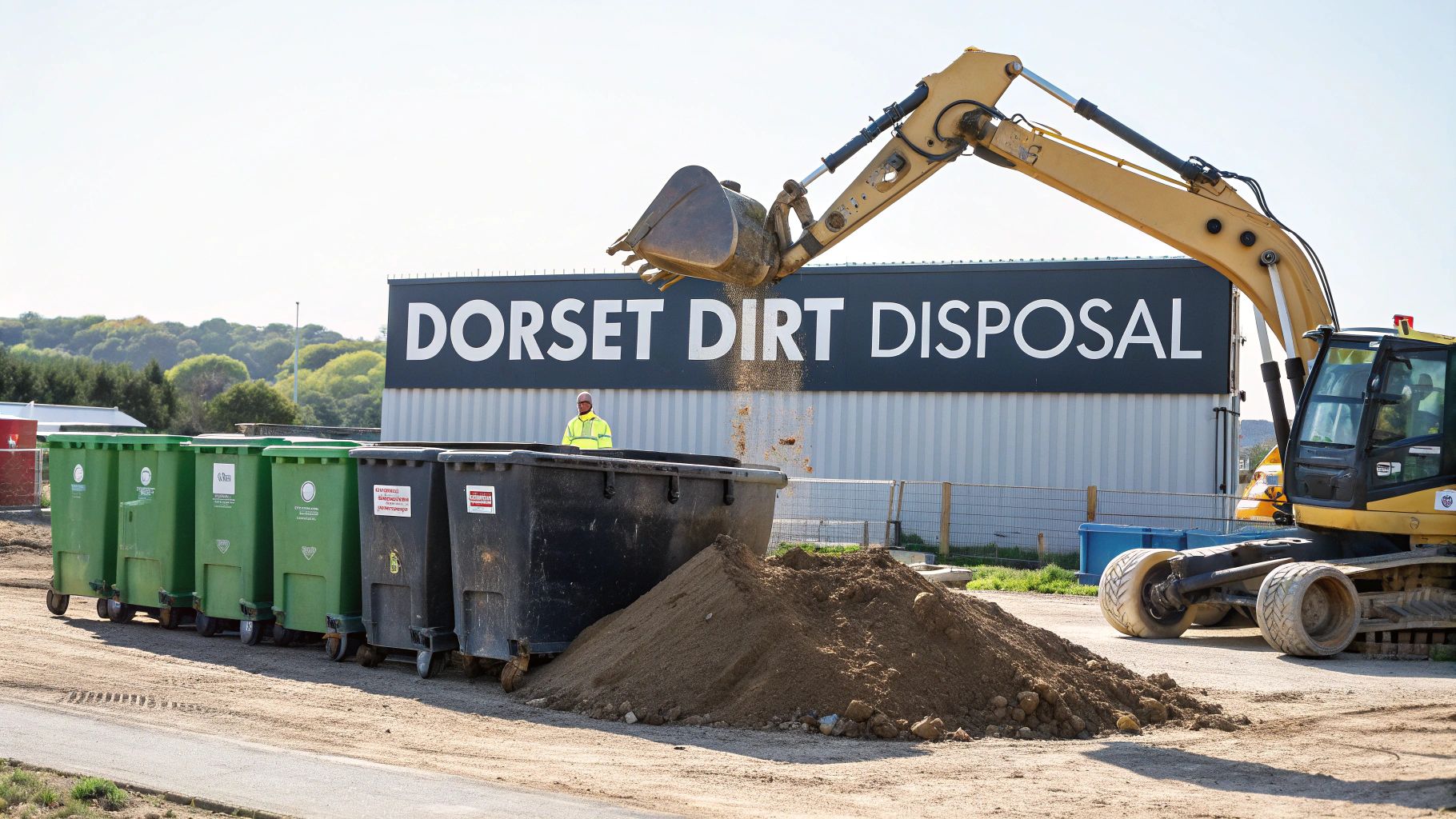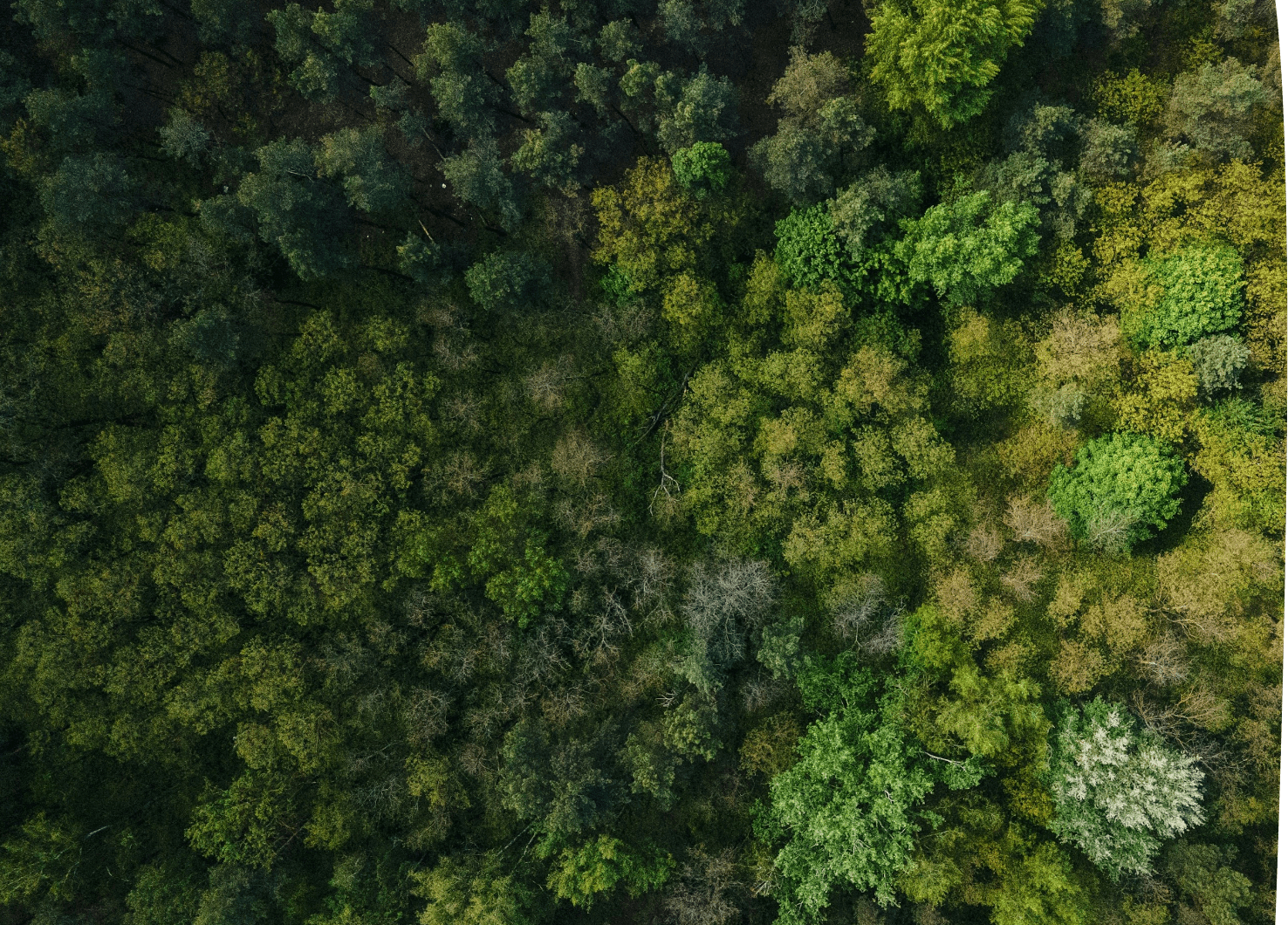The Environmental Impact of Landfills Explained
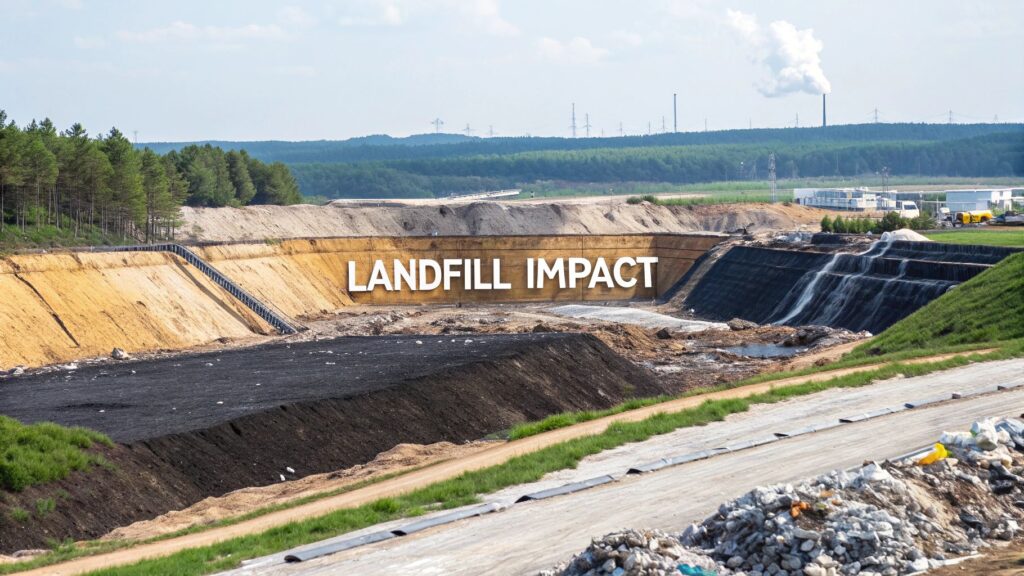
The environmental impact of landfills is huge, transforming our everyday rubbish into long-term pollution sources. These sites pump out powerful greenhouse gases like methane, poison groundwater with toxic liquids, and cause permanent damage to soil and local wildlife. They are far from being simple rubbish dumps; they are complex systems with consequences that last for generations.
Before we dive into the details, here’s a quick overview of the main environmental threats landfills pose. This table will give you a snapshot of the key issues we’ll be exploring.
Key Environmental Impacts of Landfills at a Glance
| Area of Impact | Primary Pollutant or Issue | Main Consequence |
|---|---|---|
| Air | Methane (CH₄) & Carbon Dioxide (CO₂) | Potent greenhouse gases contributing to climate change. |
| Water | Leachate (toxic liquid) | Contamination of groundwater and surface water supplies. |
| Soil | Heavy metals & chemical residues | Long-term degradation, loss of habitat, and unusable land. |
Now that you have the big picture, let's unpack what each of these impacts really means for our planet.
What Happens When We Throw Things Away?
Ever wondered where your rubbish really goes after the bin lorry disappears down the street? For a massive chunk of our waste, the final destination is a landfill—a vast, engineered site designed to contain everything we discard. But a landfill isn't just a hole in the ground; it's more like a giant, leaky battery for the planet. It’s a container built to hold tonnes of waste that, over time, inevitably begins to seep harmful substances back into the environment.
This process kicks off a chain reaction of negative effects. The breakdown of organic waste generates powerful greenhouse gases, feeding directly into climate change. Rainwater trickling through the rubbish creates a toxic sludge that threatens our water supplies. And the land itself is often scarred for centuries.
The Scale of the Landfill Challenge
Understanding the sheer volume of waste really puts the problem into perspective. The UK currently operates around 540 landfill sites to manage everything from household refuse to industrial by-products.
Each year, the UK generates roughly 220 million tonnes of waste. Around 22.8% of this—a staggering 50.6 million tonnes—ends up buried in these landfills. A huge portion of this is food waste, and its decomposition is a primary source of methane. In fact, landfill methane is estimated to account for 11% of global methane emissions.
This constant flow of rubbish places immense pressure on our environment. The substances buried in these sites often include a nasty cocktail of chemicals, heavy metals, and other hazardous materials. Getting to grips with the general category of environmental toxins gives you a good sense of the specific pollutants brewing in our landfills.
A landfill is not a final solution; it is a long-term management problem. Even after a site is closed and capped, it requires monitoring for decades, sometimes centuries, to prevent environmental contamination as the contents slowly break down.
The main consequences fall into three key areas, each posing a major threat to our ecological balance:
- Air Pollution: As organic waste rots without oxygen, it produces landfill gas—a mix of methane and carbon dioxide that seriously contributes to global warming.
- Water Contamination: Rainwater filters through the waste, creating a toxic liquid called leachate that can poison groundwater and nearby rivers and lakes.
- Soil and Land Degradation: The land used for landfills becomes contaminated and physically unstable, destroying natural habitats and making the area unusable for generations.
The Invisible Threat of Landfill Gas and Air Pollution
When we throw our rubbish away, it doesn't just vanish. Instead, it starts a slow, hidden process of decomposition deep within landfill sites, releasing a cocktail of harmful gases into our atmosphere. This is one of the biggest environmental problems with landfills, turning our everyday waste into a serious source of air pollution.
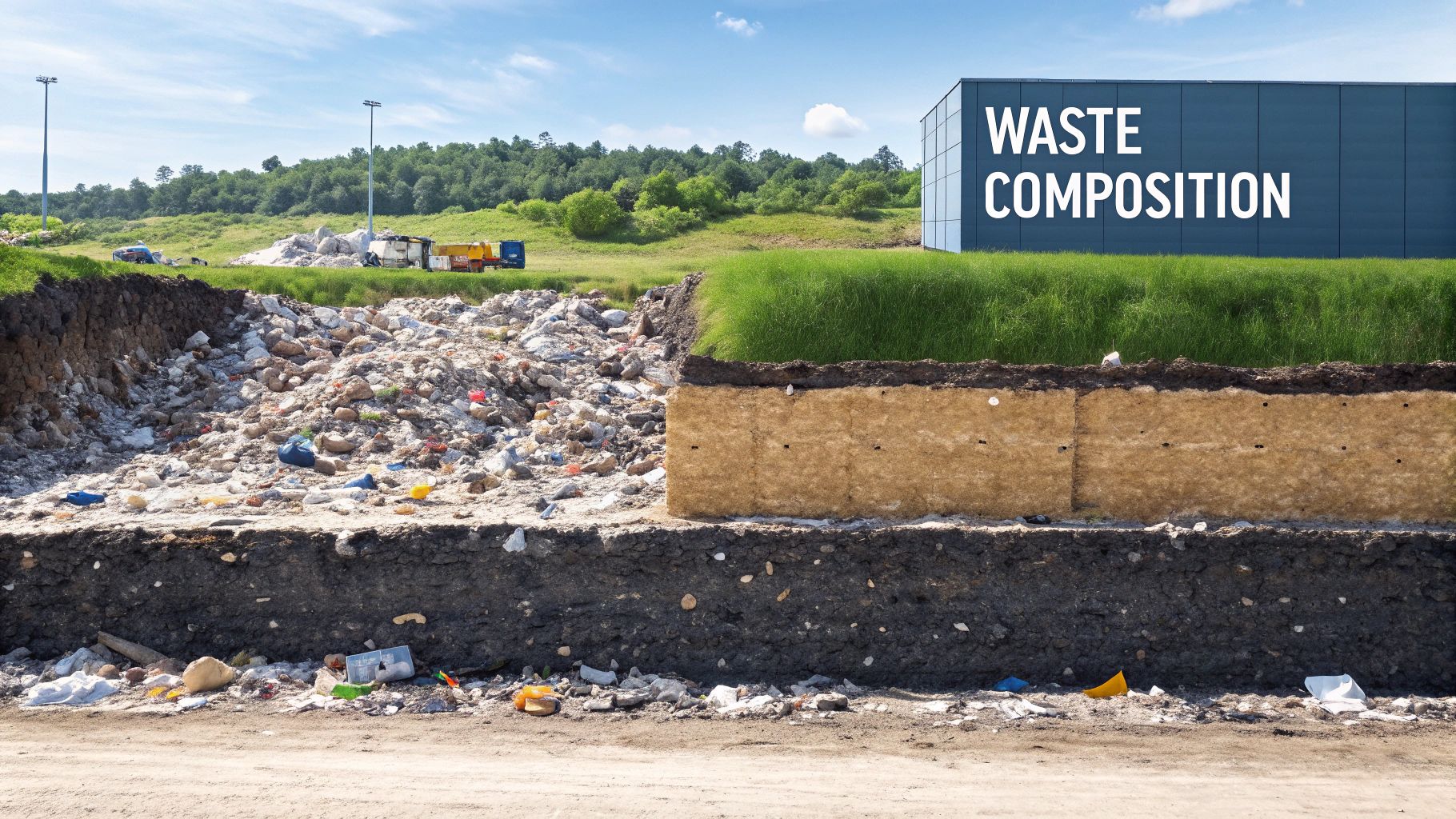
Think of a landfill as a giant, slow-motion burp from the earth. As organic materials like food scraps, paper, and garden waste get compacted under tonnes of other rubbish, they're starved of oxygen. This creates the perfect environment for anaerobic decomposition—a process where bacteria break down waste without air, producing a potent mixture we call landfill gas.
This gas is mostly made up of two main culprits: carbon dioxide (CO₂) and methane (CH₄). While both are powerful greenhouse gases, it’s the methane that really has experts worried.
Why Methane Matters So Much
Methane is a bit of a super-pollutant. Over a 20-year period, it is over 80 times more potent at trapping heat in our atmosphere than carbon dioxide, which makes it a powerful accelerator of climate change. And unfortunately, landfills are one of the UK's largest human-caused sources of methane, constantly leaking this invisible gas into the air.
The scale of these emissions is huge. Back in 2020, UK landfills released an estimated 13.6 million tonnes of CO₂ equivalent, cementing their place as a major contributor to the nation's greenhouse gas emissions from the waste sector. At that time, around 500 landfill sites were still operational, many of them nearing full capacity, which really drives home the urgent need for better ways to manage our waste.
Methane's short but intense impact means that reducing its emissions now can have a rapid and significant effect on slowing the rate of global warming. Tackling landfill gas is therefore a critical priority in the fight against climate change.
More Than Just Methane and Odour
It's not just the big greenhouse gases we have to worry about. Landfill air pollution also includes a whole range of other nasty substances. As different products break down, they release volatile organic compounds (VOCs). These can include chemicals from old paints, solvents, cleaning products, and plastics, all of which contribute to poor air quality and can pose health risks to nearby communities.
These emissions are also what cause the foul odours we often associate with landfill sites, which can massively impact the quality of life for anyone living nearby. It all adds up to a complex air pollution problem that’s much more than just an unpleasant smell.
This localised pollution really underscores the importance of proper waste disposal. While managed landfills have their challenges, the problems are made so much worse by illegal waste handling. Understanding the environmental impact of illegal dumping reveals an even more direct and uncontrolled threat to our local air and water quality.
The Community Impact of Air Pollution
For those living close to landfill sites, the environmental impact is a daily reality. The constant presence of nasty smells, potential health effects from breathing in VOCs, and the noise from site machinery all lead to a lower quality of life. The invisible threat of landfill gas becomes a very real problem for local communities.
This direct impact shows that the consequences of our waste aren't just some distant, global issue. They are felt right here, in our own neighbourhoods, making it absolutely essential that we address the root causes of landfill air pollution through better waste reduction and management.
How Landfills Create a Toxic Tea That Poisons Water
While the gassy emissions from landfills pollute the air, another, more insidious threat is quietly brewing underground. As rain falls and filters through tonnes of compacted waste, it creates a highly toxic liquid that poses a direct danger to our most precious resource: water. This poisonous liquid has a name that perfectly captures its nature: leachate.
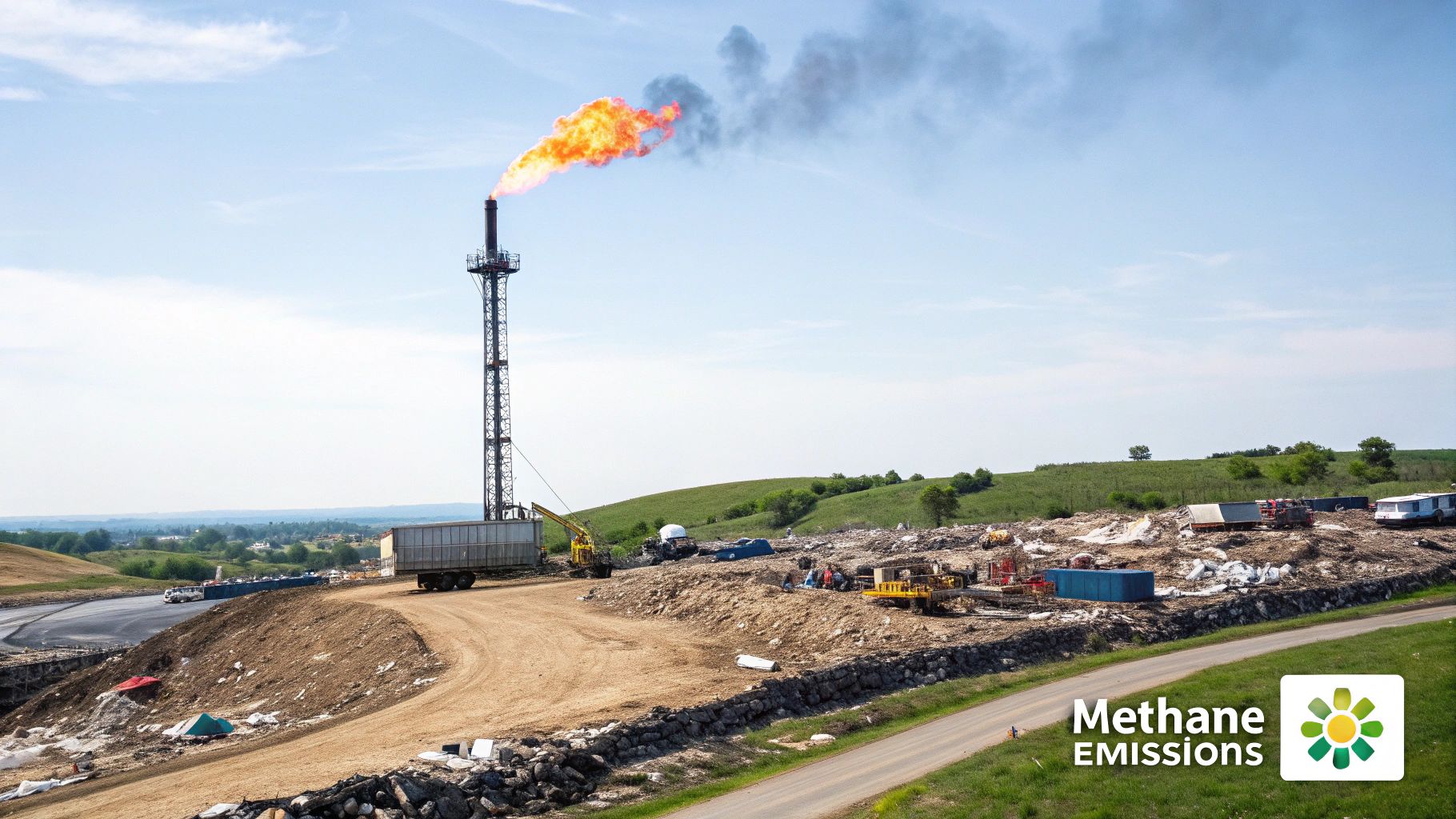
It helps to think of a landfill as a colossal, foul teabag. Every time it rains, water seeps through the layers of rubbish, dissolving a cocktail of harmful substances along the way. But this isn't your morning cuppa; it's a toxic brew steeped with chemicals from cleaning products, heavy metals from discarded electronics, and pathogens from rotting organic waste.
The Composition of Leachate
Leachate is a complex and hazardous mixture, with its exact contents varying depending on what's been thrown away. However, it typically contains a dangerous array of pollutants that can wreak havoc on the environment.
Common contaminants found in this toxic liquid include:
- Heavy Metals: Lead from old car batteries, mercury from fluorescent bulbs, and cadmium from plastics can all leach into the water.
- Ammonia: Produced during the decomposition of organic materials like food and garden waste, high levels of ammonia are lethal to aquatic life.
- Organic Compounds: Solvents, pesticides, and chemicals from industrial waste contribute to a toxic soup that can persist for decades.
- Pathogens: Bacteria and viruses from decomposing organic matter and sanitary waste can contaminate water sources, making them unsafe for consumption.
The toxic leachate from landfills, made worse by plastic waste, contributes significantly to plastic pollution in water sources. As plastics break down over centuries, they release microplastics and chemical additives that become part of this hazardous liquid, further compounding the contamination problem.
When Modern Defences Fail
You might think that modern, engineered landfills have this problem solved. They’re constructed with sophisticated liner systems—thick layers of compacted clay and durable plastic sheeting—designed to act as a barrier, containing the leachate and preventing it from escaping. These systems are a vast improvement on the old-style rubbish dumps, but they aren’t foolproof.
Over time, even the most advanced landfill liners can degrade, tear, or develop leaks. The immense weight of the waste, chemical reactions, and simple ageing can compromise their integrity, creating pathways for leachate to seep into the surrounding environment.
Once it escapes, leachate's primary target is groundwater. This is the water held underground in the soil and in the pores and crevices of rock, and it's a vital source of drinking water for many communities across the UK.
The Long-Term Consequences of Water Contamination
When leachate contaminates groundwater, the consequences are severe and long-lasting. Cleaning up polluted groundwater is an incredibly difficult and expensive process, often taking many years. For local communities, it can mean their primary water source becomes unsafe to drink, potentially for generations.
The damage doesn't stop there. Contaminated groundwater can eventually find its way into nearby streams, rivers, and lakes. This introduces a slew of toxins into surface water ecosystems, with devastating effects on wildlife. Fish can be killed off by high ammonia levels, and heavy metals can accumulate in the food chain, harming birds and other animals that rely on these water sources.
This really highlights the enduring environmental impact of landfills. The threat of leachate contamination doesn't just disappear when a landfill is closed and capped. The waste continues to decompose and produce this toxic tea for decades, sometimes even centuries, requiring constant monitoring to protect our water supplies long after we've forgotten what we threw away.
The Lasting Scars on Soil and Local Ecosystems
Beyond the damage to our air and water, landfills leave a deep and permanent physical scar on the land itself. When a site is chosen for a landfill, it isn't just being borrowed for a while; it's often being sacrificed for good. That ground becomes a long-term liability, frequently left unsuitable for farming or natural habitats for centuries.
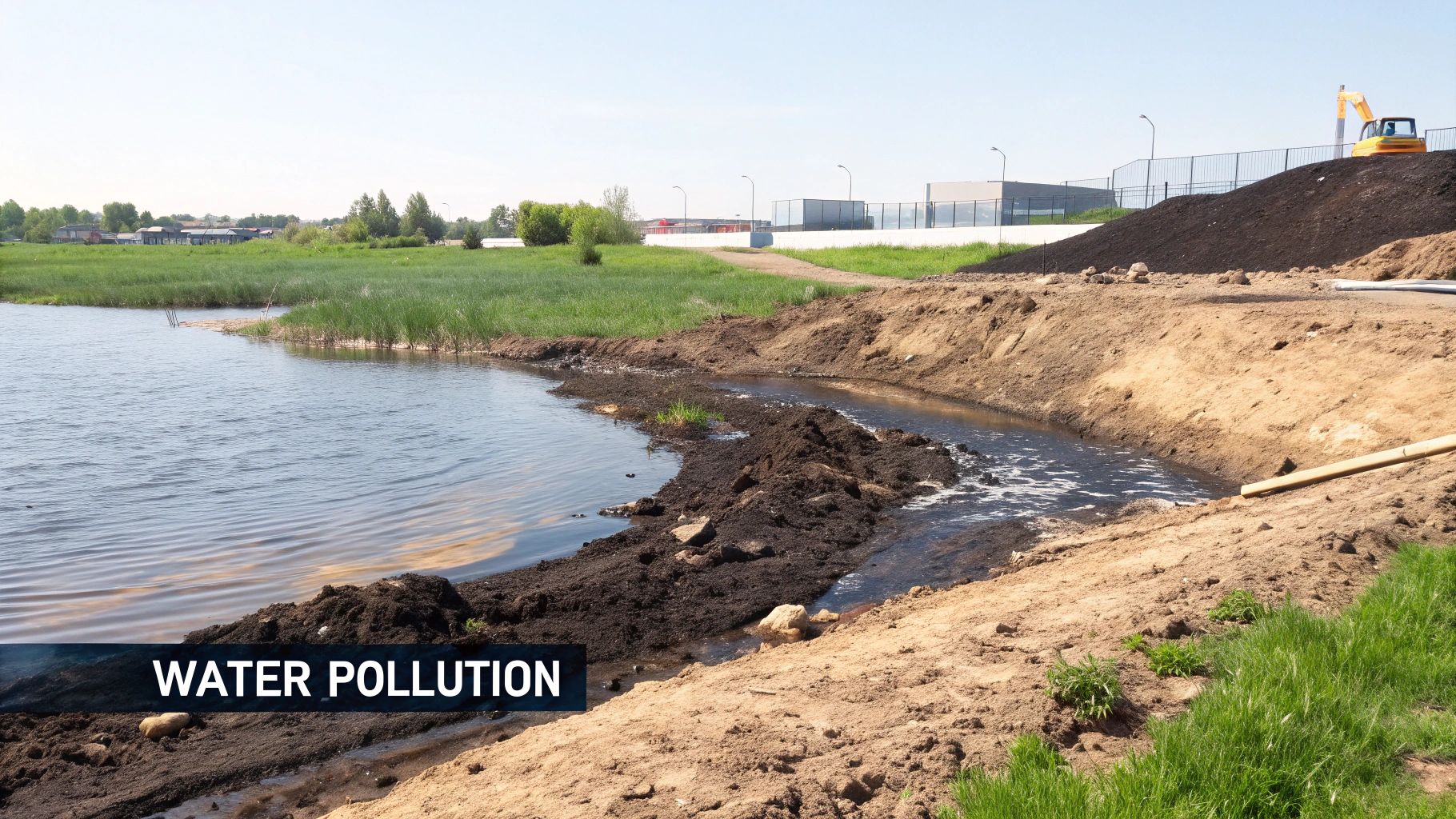
The process starts with completely clearing the land. This means destroying entire local ecosystems—stripping away trees, plants, and topsoil that once supported a rich variety of wildlife. This initial habitat destruction is the first, irreversible step in creating a dead zone where a thriving environment used to be.
Once the rubbish starts piling up, the damage digs in deeper. The soil underneath and around the landfill becomes a sink for all sorts of nasty contaminants. Even with modern liners designed to prevent leaks, small amounts of toxic leachate can still seep through, introducing heavy metals and chemicals directly into the earth.
How Landfill Waste Degrades Soil Quality
This contamination isn't just a surface-level issue; it fundamentally changes the soil's chemistry and structure. The degradation happens in a few key ways:
- Chemical Contamination: Nasty stuff from batteries, electronics, and industrial waste can poison the soil, making it toxic for plants and the microorganisms that keep it healthy.
- Microplastic Accumulation: Textiles and plastics slowly break down, shedding tiny microplastic particles that get embedded in the soil. In fact, around 60% of textiles contain these very microplastics.
- Nutrient Imbalance: The sheer concentration of decomposing materials creates an unnatural chemical environment, completely disrupting the delicate nutrient cycles that are essential for healthy soil to thrive.
Because of this long-term contamination, even after a landfill is full and capped, the land underneath remains polluted. It can’t be safely used to grow crops or re-establish a natural woodland because the risk of toxins getting into the food chain is simply too high.
The Unstable Afterlife of a Closed Landfill
Closing a landfill doesn't stop its environmental impact. The site then enters a long and expensive aftercare period because the ground itself is physically unstable. As the mountains of waste below decompose and shift, the surface can sink unpredictably in a process known as subsidence.
A closed landfill isn't a piece of reclaimed land; it's an active management site in disguise. It requires constant monitoring and maintenance to control gas emissions, manage leachate, and stop the ground from collapsing, leaving a permanent scar on the landscape.
This instability makes building anything on former landfill sites incredibly challenging and risky. The perpetual management needed shines a light on a crucial point about our waste: out of sight is definitely not out of mind.
The decisions we make about our rubbish have consequences that last for generations. The challenges of managing these sites are a key reason behind the closure of landfills in Dorset and other regions, as the long-term environmental and financial costs become all too clear.
Ultimately, the land we give over to waste becomes a permanent monument to our consumption habits. It's a stark reminder that every single item we throw away contributes to a lasting legacy of environmental damage, destroying habitats and leaving the earth scarred for centuries.
Modern Engineering to Make Landfills Safer
After looking at the serious environmental threats landfills can pose, from air pollution to contaminated water, it's easy to wonder if there’s a better way. The good news is that the old image of a simple rubbish dump is largely a thing of the past here in the UK. Modern, engineered landfills are complex facilities designed with specific tech to keep their impact to a minimum.
These sites aren't a perfect cure-all, but they represent a massive leap forward from the days of uncontrolled dumping. By using advanced containment and collection systems, today’s landfills can capture and treat the harmful by-products of our waste. They turn a potential disaster into a manageable problem, although this level of control requires constant, expensive maintenance to stay effective.
To really see the difference, it helps to compare the old with the new.
Modern Landfill Technologies vs Traditional Dumps
This table shows just how far waste management has come, comparing the basic features of an old-style dump with the engineered controls of a modern landfill.
| Feature | Traditional Dump (Uncontrolled) | Modern Engineered Landfill (Controlled) |
|---|---|---|
| Liner System | None. Waste is dumped directly on the ground. | Multi-layered composite liner (plastic geomembrane and compacted clay). |
| Leachate Management | Leachate seeps directly into soil and groundwater. | A network of pipes collects leachate for on-site treatment. |
| Gas Management | Methane and CO2 are released directly into the atmosphere. | An active gas collection system captures methane, often for energy generation. |
| Daily Cover | Infrequent or non-existent, leading to pests and odours. | Waste is covered daily with soil or alternative materials to control issues. |
| Monitoring | Little to no monitoring of environmental impact. | Continuous monitoring of groundwater, air quality, and system integrity. |
| Final Capping | Waste is often left exposed or with a simple soil cover. | An engineered, impermeable cap is installed to seal the site upon closure. |
As you can see, the focus has shifted from simple disposal to active, long-term environmental protection.
Containing the Toxic Tea with Advanced Liners
One of the most critical innovations is the composite liner system. This acts as a multi-layered barrier between the waste and the world outside. Think of it as a highly durable, industrial-grade bin bag for an entire landfill, designed to stop the toxic liquid known as leachate from seeping into the ground and poisoning water supplies.
A typical modern liner system is surprisingly complex:
- Geomembrane Liners: These are thick, tough plastic sheets, usually made from high-density polyethylene (HDPE), that are incredibly resistant to chemical corrosion.
- Compacted Clay Layers: Underneath the plastic sheeting lies a thick layer of dense, low-permeability clay, giving a natural and robust secondary barrier.
- Leachate Collection Systems: A network of pipes is laid across the liner to collect any leachate that forms, funnelling it away to an on-site treatment facility before it has a chance to build up.
At these facilities, the captured leachate is treated to remove the worst of its contaminants. Once clean, it's safe enough to be discharged into the sewer system. This contain-and-treat approach is fundamental to protecting local groundwater.
The image below shows just how vital managing landfill emissions is, illustrating a stark link between how close someone lives to a landfill and the incidence of asthma.
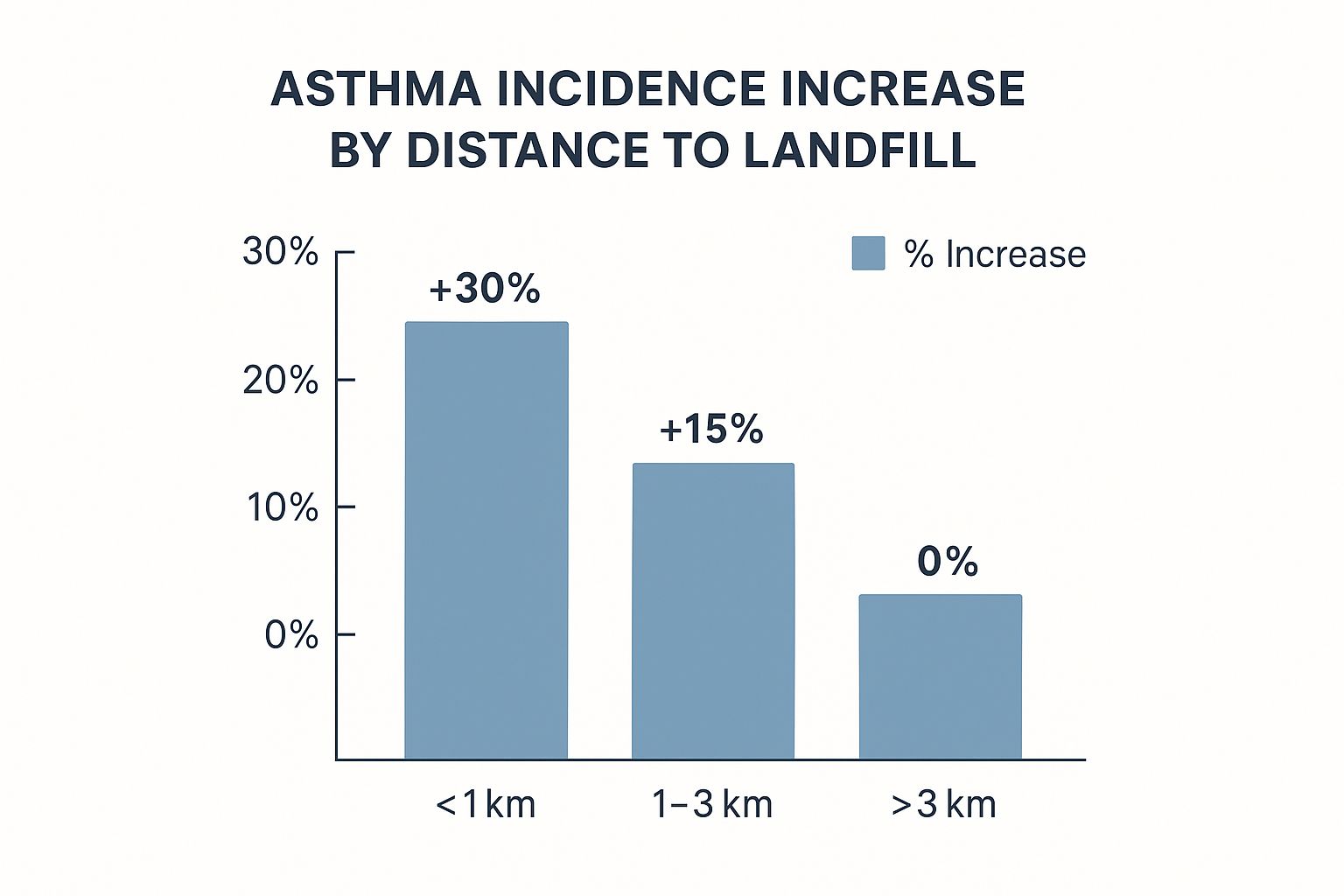
This data really brings home the tangible health risks for communities living near landfill sites, reinforcing just how necessary these effective engineering controls are.
Turning Harmful Gas into Useful Energy
Another major step forward tackles the invisible threat of landfill gas. Instead of just letting potent methane escape freely into the atmosphere and drive climate change, modern landfills are fitted with gas collection systems.
This involves drilling a network of vertical wells and horizontal pipes deep into the waste. A vacuum system then actively sucks the landfill gas out of the ground, piping it to a central processing plant where it can be put to surprisingly good use.
Many modern landfill sites now operate as gas-to-energy facilities. The collected methane is cleaned up and then burned to power turbines or engines that generate electricity. This not only stops a powerful greenhouse gas from escaping but also creates a source of renewable energy that can be fed back into the national grid.
This process has made a huge difference to the environmental footprint of UK landfills. Between 2010 and 2023, greenhouse gas emissions from landfills in the United Kingdom fell by roughly 14.5 million metric tons of carbon dioxide equivalent. That's an impressive reduction, reflecting the success of better waste policies and, crucially, the widespread adoption of landfill gas capture tech. You can dig into the numbers yourself by exploring the latest UK waste management statistics on Statista.com.
These engineering solutions show a real commitment to softening the environmental blow of landfills. While they add complexity and cost to waste management, they are absolutely essential for protecting our health and the environment. They transform landfills from passive dumps into actively managed systems, but they also highlight a vital point: the best solution is always to reduce the amount of waste we create in the first place.
Sustainable Alternatives and the Path Forward
While modern engineering has certainly made landfills safer, these measures are really just treating the symptoms of our wider waste problem. Patching up the issue is one thing, but the real solution is to change our entire approach.
We need to move away from our throwaway culture and towards a system where landfills are the absolute last resort, not the default destination for our rubbish. This shift is all about following a simple but powerful framework: the waste hierarchy.
Think of it as an upside-down pyramid. At the top—the widest and most important part—is Reduction. Just below that, you have Reuse, followed by Recycling. Right at the bottom, the smallest point of the pyramid, is Disposal, which includes landfills. Focusing on those top layers is the key to truly minimising our reliance on burying our rubbish.
Adopting the Waste Hierarchy Principles
Putting these principles into practice is the single most effective way to tackle the problem at its source. For both households and businesses, this boils down to making conscious choices every day to cut down on what we throw away.
Here are a few practical steps that make a huge difference:
- Reducing Consumption: This could mean saying no to fast fashion, where a shocking 66% of discarded textiles end up in landfills, or simply choosing products with less packaging at the supermarket.
- Choosing Reusable Options: Swapping single-use items like disposable coffee cups and plastic bags for durable alternatives is a small change that adds up to a massive impact over time.
- Supporting Repair and Refurbishment: Before you replace a faulty appliance, see if you can get it fixed. A local repair shop can extend its life and keep it out of the waste stream completely.
These actions are the foundation of more sustainable waste management strategies, creating a ripple effect that eases the immense pressure on our landfill capacity.
Advanced Waste Management Solutions
Beyond our individual efforts, larger-scale technologies are crucial for dealing with the waste we can't avoid creating. These advanced solutions are designed to pull value from our rubbish, turning potential pollutants into useful resources and diverting enormous volumes of material away from landfill sites.
A truly circular economy doesn't just manage waste; it redefines it. Materials that were once considered rubbish are seen as valuable resources, ready to be transformed into something new.
Several key technologies are leading this charge:
- Industrial Composting: This process takes organic waste like food scraps and garden trimmings and turns it into nutrient-rich compost for agriculture. Of course, you don't need an industrial facility to make a difference—learning how to compost at home is one of the best ways to keep food waste out of landfill while improving your own soil.
- Anaerobic Digestion: Inside sealed, oxygen-free tanks, tiny microorganisms get to work breaking down food and agricultural waste. This process produces biogas, which can be captured and used to generate electricity and heat. The leftover solid material, known as digestate, also makes for an excellent fertiliser.
- Waste-to-Energy (WtE) Facilities: These modern plants incinerate non-recyclable waste in a highly controlled environment to generate electricity. While they offer a smart way to recover energy from what's left, they must be managed carefully to control air emissions and handle the resulting ash responsibly.
Each of these alternatives has a vital role to play in building a more circular economy. By embracing reduction, reuse, recycling, and these advanced recovery technologies, we can start to see landfills for what they should be—a final option for a tiny fraction of our waste, not the cornerstone of our entire disposal system.
Your Landfill Questions Answered
Even after getting a clearer picture of how landfills affect the environment, it's natural to have a few more specific questions. Let's tackle some of the most common ones to really cement what we've covered and give you a quick reference for the essential facts.
Getting your head around these details is the key to understanding why sending less to landfill is so critical.
How Long Does Rubbish Actually Take to Break Down?
It’s a common misconception that rubbish just rots away quickly once it's buried. In reality, a modern landfill is a surprisingly slow place for decomposition. Everything is compacted so tightly that there’s very little oxygen, which is essential for a rapid breakdown. This creates an environment where some everyday items are preserved for a staggering amount of time, turning today's rubbish into a problem for generations to come.
Just look at how long some common items stick around:
- Organic Waste: Food scraps and garden cuttings might be gone in a few months to a couple of years.
- Plastic Bags: These can hang around for up to 1,000 years.
- Glass Bottles: It’s thought that glass might never fully decompose in a landfill. It just sits there, indefinitely.
This incredibly slow decay is exactly why landfills remain an environmental issue long after they’ve been capped and closed.
Is It Safe to Live Near a Modern Landfill?
Here in the UK, modern landfills are a world away from the old open dumps. They are built to incredibly strict standards, using clever engineering to minimise health risks. Features like gas collection systems and heavy-duty liners are designed to contain the pollution.
But that doesn't mean they're perfect.
While regulations make today's landfills far safer, potential problems like persistent odours, noise from trucks and machinery, and the long-term risk of a liner or pipe failing are still valid concerns for nearby communities. Your quality of life can definitely be affected.
The engineering helps manage the risks, but it doesn't eliminate them entirely.
Does Recycling Really Make a Difference to the Landfill Problem?
Yes, absolutely. Recycling is one of the most powerful and direct actions we can all take. Every single can, bottle, or piece of cardboard that goes into the recycling bin is one less item adding to the mountain of waste.
It tackles the problem from several angles:
- It Saves Space: This is the most obvious one. Recycling directly cuts down the amount of rubbish we have to bury, which extends the life of our existing landfills and reduces the pressure to build new ones.
- It Slashes Emissions: When we keep organic waste and other materials out of landfill, we prevent them from creating harmful methane gas and toxic leachate in the first place.
- It Conserves Resources: Recycling reduces the need to mine, log, and manufacture new materials from scratch. This saves a huge amount of energy and prevents the environmental damage that comes with extracting raw resources.
When you get right down to it, recycling is the cornerstone of managing our waste properly. It’s a simple, effective way to shrink the legacy we leave for future generations.
At The Waste Group, we believe that responsible waste management starts with making the right choices. Whether you're clearing out your garden or managing a large construction site, our reliable skip hire and waste disposal services ensure your waste is handled ethically and with a focus on recycling. Book your skip online today and take a positive step towards a cleaner environment.

